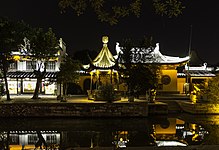| Guanghui Palace | |
|---|---|
| 广惠宫 | |
 Guanghui Palace Guanghui Palace | |
| Religion | |
| Affiliation | Taoism |
| Location | |
| Location | Nanxun, Huzhou, Zhejiang |
| Country | China |
 | |
| Geographic coordinates | 30°52′33.81″N 120°25′34.74″E / 30.8760583°N 120.4263167°E / 30.8760583; 120.4263167 |
| Architecture | |
| Style | Chinese architecture |
| Date established | 1064–1067 |
| Completed | 2003 (reconstruction) |
Guanghui Palace (simplified Chinese: 广惠宫; traditional Chinese: 廣惠宮; pinyin: Guǎnghuì Gōng), commonly known as Zhang–Wang Temple (张王庙; 張王廟; Zhāng–Wáng Miào), is a Taoist temple located in Nanxun of Huzhou, Zhejiang, China.
History
The temple was first established in the reign of Yingzong of the Northern Song dynasty (960–1127). In late Yuan dynasty (1271–1368), Zhang Shicheng used the temple as his Xinggong (Chinese: 行宫; lit. 'imperial palace for short stays away from the capital'). It has been burned down and rebuilt several times, due wars and natural disasters. The current temple was rebuilt in 2003.
Architecture
The statues of Three Pure Ones are enshrined in the main hall of the temple.
References
- 浙江这座藏在古镇里的道观,曾三毁三建,迄今已有上千年历史 [The Taoist temple in the ancient town, once was burned and rededicated three times, has a history of thousands of years]. 163.com (in Chinese). 2018-10-03.
- ^ 广惠宫 [Guanghui Palace]. huzhou.gov.cn (in Chinese). 2013-06-20. Archived from the original on 2019-04-06. Retrieved 2019-04-06.